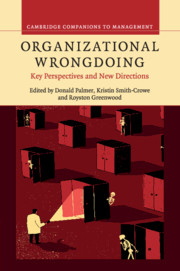Book contents
- Frontmatter
- Contents
- List of figures
- List of tables
- List of contributors
- Foreword
- 1 The imbalances and limitations of theory and research on organizational wrongdoing
- 2 On taking the theoretical substance of outcomes seriously: a meta-conversation
- 3 Wrong paths to right: defining morality with or without a clear red line
- 4 From market enablers to market participants: redefining organizational and political-legal arrangements and opportunities for financial wrongdoing,1930s–2000
- 5 Wrongdoing and market development: an examination of the distinct roles of trust and distrust
- 6 Bad apples, bad barrels and bad cellars: a “boundaries” perspective on professional misconduct
- 7 S/he blinded me with science: the sociology of scientific misconduct
- 8 Social networks and organizational wrongdoing in context
- 9 Falling stars: celebrity, infamy, and the fall from (and return to) grace
- 10 Compensation and employee misconduct: the inseparability of productive and counterproductive behavior in firms
- 11 Beware of organizational saints: how a moral self-concept may foster immoral behavior
- 12 “Is it me? Or is it me?” The role of coactivated multiple identities and identifications in promoting or discouraging workplace crimes
- 13 Consequences of organizational misconduct: too much and too little punishment
- 14 Who bears the brunt? A review and research agenda for the consequences of organizational wrongdoing for individuals
- 15 Organizational wrongdoing and media bias
- 16 Ethical learning: releasing the moral unicorn
- Index
- References
4 - From market enablers to market participants: redefining organizational and political-legal arrangements and opportunities for financial wrongdoing,1930s–2000
Published online by Cambridge University Press: 05 July 2016
- Frontmatter
- Contents
- List of figures
- List of tables
- List of contributors
- Foreword
- 1 The imbalances and limitations of theory and research on organizational wrongdoing
- 2 On taking the theoretical substance of outcomes seriously: a meta-conversation
- 3 Wrong paths to right: defining morality with or without a clear red line
- 4 From market enablers to market participants: redefining organizational and political-legal arrangements and opportunities for financial wrongdoing,1930s–2000
- 5 Wrongdoing and market development: an examination of the distinct roles of trust and distrust
- 6 Bad apples, bad barrels and bad cellars: a “boundaries” perspective on professional misconduct
- 7 S/he blinded me with science: the sociology of scientific misconduct
- 8 Social networks and organizational wrongdoing in context
- 9 Falling stars: celebrity, infamy, and the fall from (and return to) grace
- 10 Compensation and employee misconduct: the inseparability of productive and counterproductive behavior in firms
- 11 Beware of organizational saints: how a moral self-concept may foster immoral behavior
- 12 “Is it me? Or is it me?” The role of coactivated multiple identities and identifications in promoting or discouraging workplace crimes
- 13 Consequences of organizational misconduct: too much and too little punishment
- 14 Who bears the brunt? A review and research agenda for the consequences of organizational wrongdoing for individuals
- 15 Organizational wrongdoing and media bias
- 16 Ethical learning: releasing the moral unicorn
- Index
- References
Summary
It is widely accepted that the spread of high-risk financial instruments and financial wrongdoing contributed to failures in the US home mortgage market, the 2008 financial crisis, and upheaval in the global economy. Initially, corporate leaders, government officials, and some researchers attributed the crisis to individuals and suggested that individual characteristics such as greed and self-interest explain these events. Clearly, the perpetrators of financial wrongdoing are individuals with self-interests. However, the focus on individual characteristics does not answer an important question: Why was financial wrongdoing so widespread in financial markets at this point in history?
Current research shows that corporate wrongdoing occurs in response to cognitive assumptions (Gabbioneta, Prakash, and Greenwood 2014), risk-taking norms (Abolafia 2010), and is normal and undetectable in complex structures where bounded rationality impedes social actors from grasping the implications of their decisions (Palmer 2013; Palmer and Maher 2010). Others maintain that Congress and the Executive Branch facilitated the emergence of financial markets and risky financial instruments (Campbell 2010; Krippner 2011; Lavelle 2013), and the federal government “pulled the banks into the … secondary mortgage market” and trusted that banks understood what they were doing (Fligstein and Goldstein 2010: 31, 63–64). Still others show that whereas the multilayer-subsidiary form created opportunities, pressure to increase shareholder value created incentives for managers to engage in financial wrongdoing (Prechel and Morris 2010).
Although these studies advance our understanding of corporate wrongdoing, little research exists on how interrelated parts of the social structure were changed in ways that created opportunities for social actors to engage in wrongdoing in the first place. We suggest that this lacuna in the literature exists because of the increased specialization and division within the social and organizational sciences and the narrow focus on a single dimension of the social structure. To fill this gap in the literature, we elaborate Sutherland's (1949) conception of differential social structure and focus on the following questions. How were the organizational and political-legal arrangements transformed in ways that created opportunities for social actors to engage in financial wrongdoing? How did the emergent organizational and political-legal arrangements interact to create opportunities for financial wrongdoing?
- Type
- Chapter
- Information
- Organizational WrongdoingKey Perspectives and New Directions, pp. 77 - 113Publisher: Cambridge University PressPrint publication year: 2016
References
- 2
- Cited by



